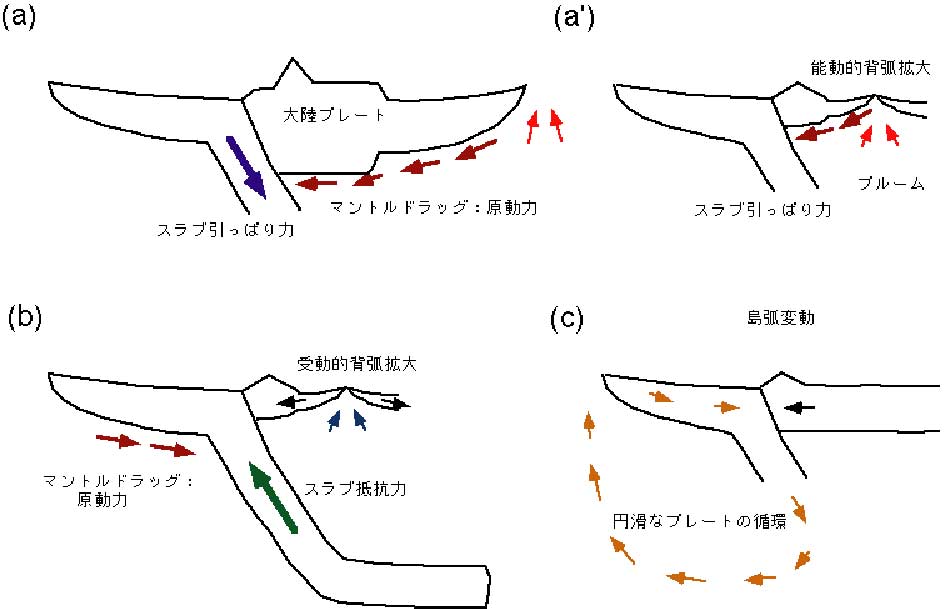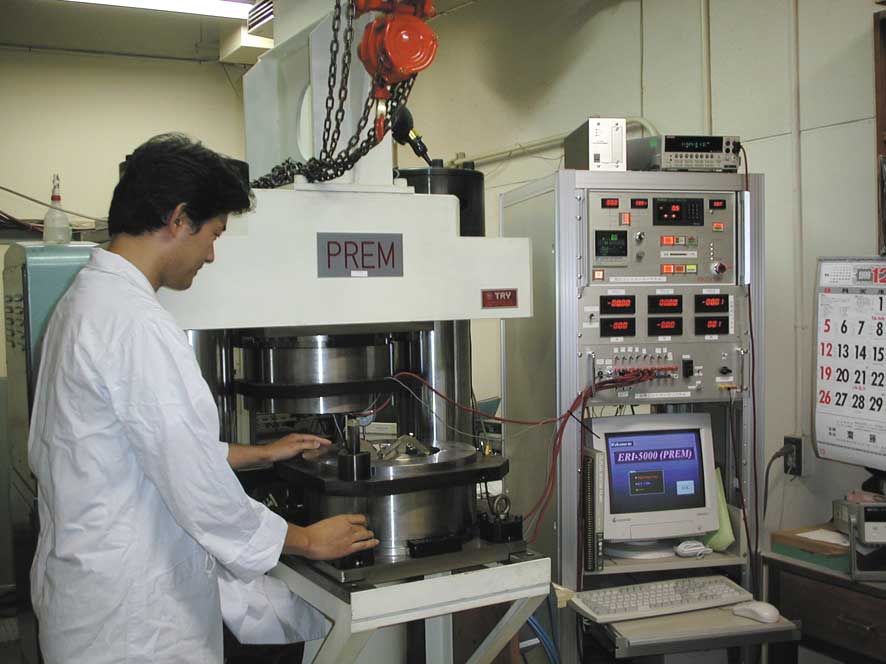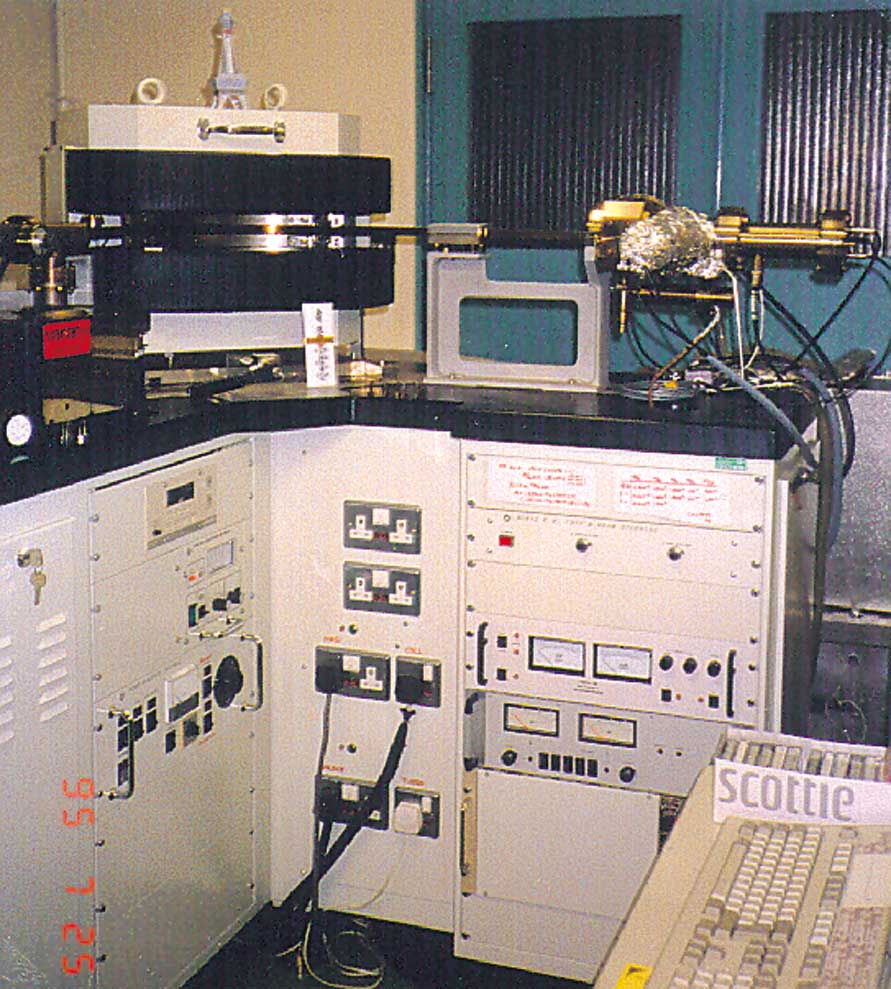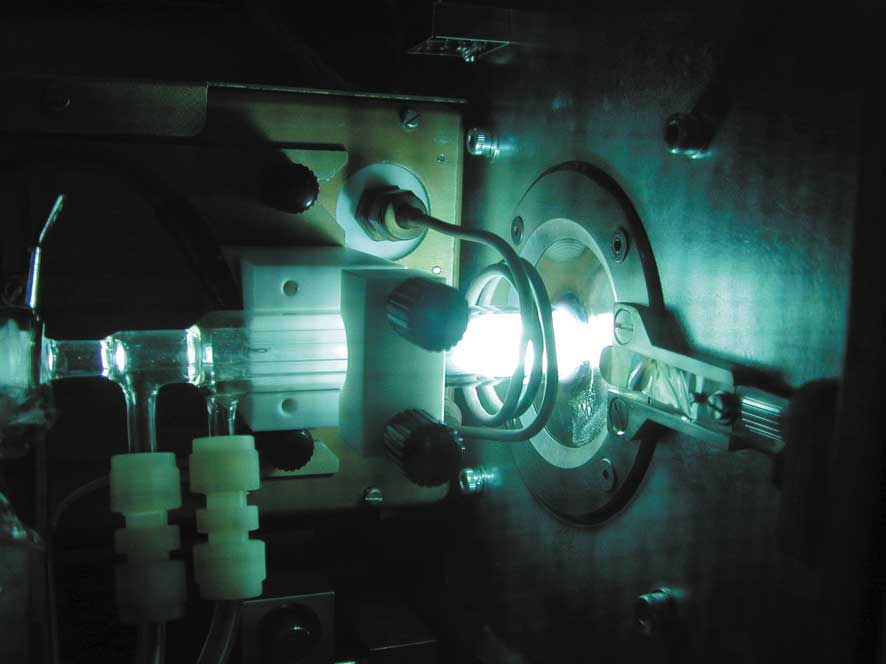
In the Global Tectonics Group, the aim is to reveal origins of various
types of tectonics on the Earth's surface from the viewpoint of
the global dynamics of the Earth's interior. Tectonics is the surface
expression of the mechanical work done in association with the
evacuation of the heat generated within the Earth's mantle. It is believed
that the tectonics of the present Earth has a form of plate
tectonics. Plate tectonics is characterized by weak plate boundaries,
and in this case, the form of the mantle convection with plates is
close to the convection of a fluid with uniform viscosity. However,
the actual states of stresses within plates indicate that this is not
the case; in many cases, the convection style deviates from the uniform
viscosity one. Active tectonics, such as the continental drifts
and back-arc spreading, is seen in such cases. This indicates that
the deviation from plate tectonics is rather the cause of the various
active tectonics seen on the Earth's surface (Fig.1). The following
themes are currently investigated: (1) Plate motions around the
Japanese islands, (2) stresses within plates and slabs, (3) driving
forces of plates, (4) mechanisms of slab earthquakes, and (5) Archean
tectonics and evolution of environment.

ig.1. Three categories of tectonics (a) and (a') Slab pull force
is dominant and balanced with the collision force.
(b) Negative slab pull force is balanced with the mantle drag
force beneath the oceanic plate. (c) Plate recycles in
a smooth way along with the mantle convection,
and normal island arc tectonism occurs in the upper plate.
Non-trivial tectonics occurs in the cases other than case (c).
In the Magma Research Group, various studies on magmas have been conducted
based on field studies and high pressure experiments
(Fig.2). Temporal variations in magmatic composition of several active
volcanoes have been studied to understand the mode of their
future eruptions. Studies on the genesis of primary magmas have been
conducted to understand the thermal condition and the
chemical composition of upper mantle. Experimental studies on magmas
at high pressures have also targeted to understand the
crystallization process of the magma ocean in the early stage of the
Earth. As we recently found aqueous fluids behave like magma at
high pressure, aqueous fluids in mantle condition became our research
targets. Our recent research themes are as follows. (1) Study
on Deccan flood basalts, (2) Experimental study on the genesis of continental
flood basalt magma, (3) Experimental study of the
composition and the behavior of aqueous fluid in the mantle, (4) Temporal
variations of magmatic compositions of Izu-Oshima, Asama,
and MIyake-jima volcanoes, (5) Role of water in the crystallization
of island-arc magmas, (6) Petrological study of Miyakejima 2000

Fig.2. Ultra-high pressure apparatus (PREM). By assembling eight
anvils made of WC, it can generate pressure up to
25 GPa and temperature up to 2500°C in the octahedral
volume of 2-10 cubic milimeters at the central part.
In the Group Researching the Evolution of Terrestrial Materials, the
aim is to reveal the evolution of the Earth through the study of
volcanism on a global scale and the role of volatile elements in the
Earth's interior. Since the presence of volatile elements in the
mantle will affect the characteristics of mantle materials seriously,
it is important to examine the present and the past states of
volatile elements in the Earth's interior, which has not well been
studied. To reveal such points, chemical and isotope (noble gases,
10Be/9Be) compositions, radiometric (K-Ar, Ar-Ar, 14C) ages, and mineral
compositions have been investigated for mantle-derived
rocks and minerals, in addition to extra-terrestrial materials (Fig.3).
The following themes are being investigated at present: (1) Present
state of volatile elements in the Earth's interior, (2) Origin of volatile
elements in kimbelites, (3) Relationship between a hotspot
volcano and a mantle plume, (4) Recycled materials in the Earth's interior
and the chemical structure of the Earth, (5) Relationship
between plateau formation and mantle plumes and formation ages of plateaus,
(6) Material transfer and chemical characteristics at a
spreading system, (7) Verification for the contribution of sediments
to the arc magma under the Japanese Islands based on 10Be.
In the Geochemistry Group, we investigate the geochemical evolution
of the earth and material transfer including phenomena related
to volcanic activity. Our current main topics are 1) to put geochronological
constraints on the time scale of volcanisms in subduction
zones, and 2) to reconstruct the course of the chemical evolution of
a magma, during production, as well as the transportation, and
the eruption of magma by micro-analytical techniques to read geochemical
records in volcanic products. We will tackle the first target
by uranium radioactivity disequilibrium method. It is considered that
magmatism in subduction zones is triggered by addition of fluid
expelled from a subducting slab. The addition of uranium by the dehydration
events forms radioactivity disequilibrium between 238U and
230Th. Taking advantage of the phenomenon, we can put constraints on
the time scale of magma movements from magma formation to
eruption. We have established a procedure to analyze the radioactivity
disequilibrium by using an multi-collector Inductively Coupled
Mass Spectrometer (MC-ICP-MS) installed in ERI (Fig.4). We just started
to apply this method to Izu arc as a test field. For the second
target, we have established analytical protocols for trace elements
by a Laser Ablation system coupled with an ICP-MS. We also
established a micro-drilling technique for Sr isotopic analysis in
a plagioclase phenocryst. We applied the two techniques to plagioclase
samples extracted from volcanic products from Unzen. Apart from the
two projects, we established analytical schemes for Li and Pb
isotopic analysis. Two elements will work as powerful tracers to investigate
material transfer in subduction areas. In addition, we have
undertaken the developments of analytical procedures for Hf isotopic
analysis to investigate genesis of Archean komatiites and of
Platinum Group Elements analysis to investigate core-mantle interaction.

Fig.3. Noble gas mass spectrometer (VG5400).

Fig.4. Ion source of Inductively Coupled Plasma Mass Spectrometer
(Micromass IsoProbe). This mass-spectrometer
produces precise isotopic data for Th, Pb, Li, Sr and other elements.
The ICP ion source of this mass spectrometer enabled isotopic analysis for small amount of thorium (10ng).